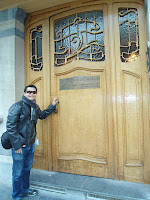The Four Major Town Houses by Victor Horta
The appearance of Art Nouveau in the closing years of the 19th century marked a decisive stage in the evolution of architecture, making possible subsequent developments, and the four town houses of Victor Horta in Brussels (Hôtel Tassel, Hôtel Solvay, Hôtel van Eetvelde, Maison et Atelier Horta) bear exceptional witness to its radical new approach. They brilliantly illustrate the transition from the 19th to the 20th centuries in art, thought and society.
The stylistic revolution represented by these works is characterized by their open plan, the diffusion of light, and the brilliant joining of the curved lines of decoration with the structure of the building.
The Hôtel Tassel can be considered the founding work of Art Nouveau.
Commissioned by Professor Emile Tassel in 1893, it was the first work in which Horta was able to realize his original conception of architecture. The house was finished in 1894, but Horta continued designing the furniture for some years. After the Second World War, the house was split into small flats so that little of the decoration remained visible.
 In 1976 the street facade and the main doors were restored and the building was adapted as prestige offices. The street facade, built from stone, is remarkably integrated into its context. Above the entrance there is a two-storey bow window in an innovative steel structure.
In 1976 the street facade and the main doors were restored and the building was adapted as prestige offices. The street facade, built from stone, is remarkably integrated into its context. Above the entrance there is a two-storey bow window in an innovative steel structure. On the street site the building has the entrance floor, a mezzanine, first and second floor, and an attic. These levels are shifted towards the garden side by way of a central staircase.
The four town houses by Victor Horta form an essential link from the classical tradition to the Modern Movement in the history of architecture, as conceived by one of the pioneers of Art Nouveau.
He revolutionized the architectural concepts of his time by introducing the idea of an open plan and creating real dialogue of materials and their uses according to their intrinsic nature within a new way of conceiving decoration. The Horta buildings revive the 19th-century tradition of bourgeois residential buildings, combining residential and representational functions, which require a subtle organization of spaces and differentiated circulation.
In each case, Horta's genius created a coherent unity of architecture and decoration, reflecting the personality of the owner.







